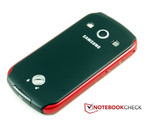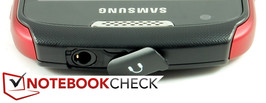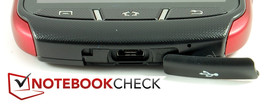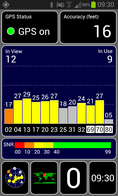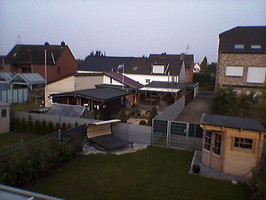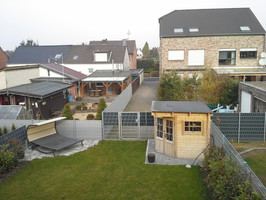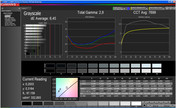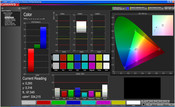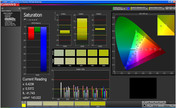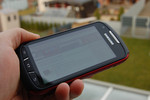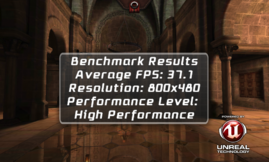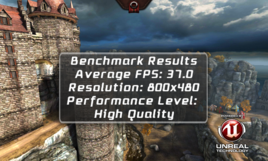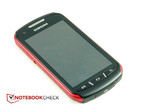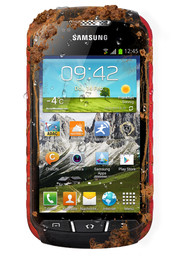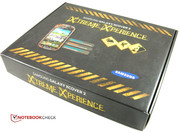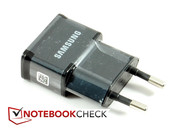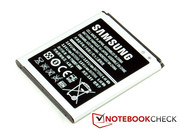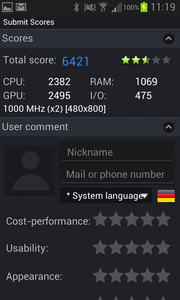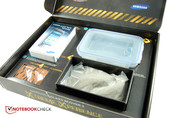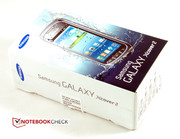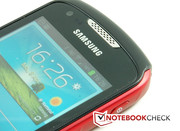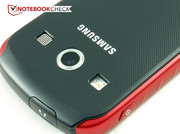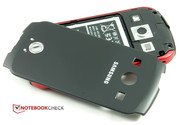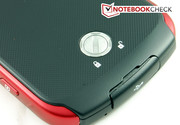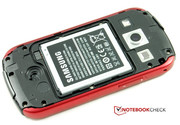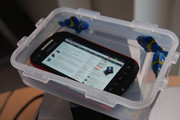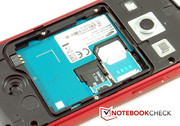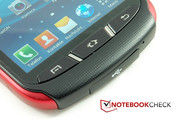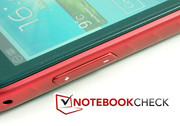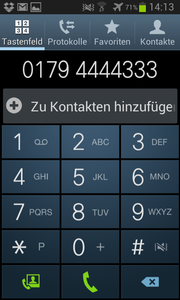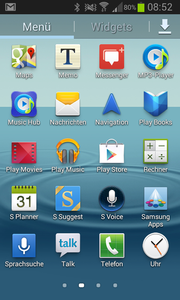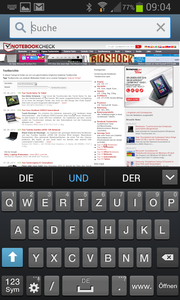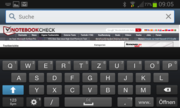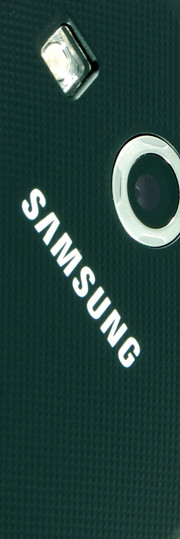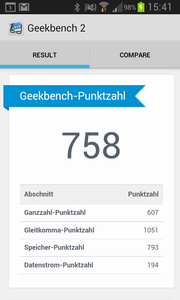Review Samsung Galaxy Xcover 2 GT-S7710 Smartphone

For the original German review, see here.
Samsung fired a starting signal into the modern outdoor smartphone market with the release of their Galaxy Xcover. Moreover, the Koreans enjoyed rightfully deserved success. Many buyers seeking rugged electronic companions, whether for sports or adventures, found what they were looking for in the Xcover -- despite some flaws, like the poor resolution and somewhat meager memory. Now Samsung wants to nullify the criticism with their Xcover 2 GT-S7710. To that end the manufacturer outfitted the phone with a dual-core CPU with a clock frequency of 1000 MHz and a not yet specified graphics unit. The working memory was doubled to 1 GB, and there are 4 GB of internal memory.
The display received the most attention in the overhaul process. Step one; it grew from 3.65 inches to 4 inches. Step two; the weak resolution, which was the main point of criticism, was increased to accommodate customers' demands -- though 480x800 pixels still are not that many. The cameras now have resolutions of 0.3 (front) and 5 megapixels (back). All in all, these are essentially the measurements of a classic mid-class smartphone. However, the features that make the Samsung Galaxy Xcover 2 into an outdoor device rescue the phone from floundering among the masses. More on that subject in the next section, "Case".
Case
At first glance the Samsung Galaxy Xcover 2 looks like any other mid-class smartphone. Only the physical Android keys beneath the 4-inch display catch your eye. At closer look, you also notice that the ports and connections are hidden underneath a protective cover. Then if you take the device in your hand, you feel the roughened plastic back, and it becomes obvious that the Xcover 2 is not one of the lightest and thinnest phones of its kind. At a weight of 150 grams (~5.3 ounces) and a depth, length and width of 12.1 x 131 x 68 millimeters (~0.48 x 5.16 x 2.68 inches) it is certainly a bit bulky, but considering its aspiration to be a device for outdoor use, that is no real disadvantage.
Definitely not a disadvantage: Samsung took several measures to protect the inner life of the phone from water and dirt. The case belongs to the protection class IP67, which means it should keep dirt from penetrating through to the components, and a temporary water bath should do it no harm. So that it could be tested immediately, the manufacturer put together a special edition for the press called "Extreme Experience". In the very large box, alongside the smartphone we found a Tupperware with three plastic fish, a bag of sand and a blow-up bat. Of course, we could not pass up the opportunity to put the device through this special test course -- after we finished all our own tests. The rugged smartphone made it through that obstacle course unharmed. Even an accidental run through the washing machine should not pose much of a threat to the Samsung Galaxy Xcover 2. The case is also impossible to twist and pressure resistant.
Connectivity
The manufacturer makes no mention of the specific hardware components they built into the Xcover 2, and even the familiar CPU identification tools fail to read the SoC type (system on a chip). But there is a CPU with very similar specifications that was used in the Galaxy S3 Mini, which was just released a few months ago: The ST Ericsson NovaThor U8500, whose two cores work at a frequency of up to 1000 MHz. We assume the same chip is at work in the Xcover 2, but should we err in this deduction, we will of course promptly correct/update this paragraph. An ARM Mali-400 MP graphics card is integrated in the SoC, in this case only equipped with one core. The working memory amounts to 1 GB -- much more is not to be expected in this price class. The internal memory is a different story: 4 GB is not very much. The fact that only 800 MB of that remains open after the initial startup is even less agreeable to us. The memory can be expanded to up to 32 GB using a microSD card. Anyone purchasing a Samsung Galaxy Xcover 2 should go ahead and buy the extra memory along with it.
There are few ports on the outdoor cell phone from Korea: two, to be exact. The 3.5 mm headphone jack is located on the upper rim, the combined USB-charger connection on the lower rim. The control buttons flank the left and ride sides.
Software
The Android 4.1.2 operating system comes with a fairly new (though not the newest) version of Google's Jelly Bean. Samsung superimposed the already familiar Touchwiz interface over the OS, which changes numerous icons, integrates Samsung's own apps and brings along an edited version of the standard Android keyboard, among other things. But Samsung was conservative in their meddling with the Android system, so it is easy to adjust to the new interface.
Communication & GPS
The Samsung Galaxy Xcover 2 communicates wirelessly via WLAN, of course. To that end the Koreans installed a single band module that transmits over 2.4 GHz bands and supports the standards 802.11b/g/n. With the 4.0 version of Bluetooth, the connection is up to date. Older versions clearly suffer when it comes to energy management. The mobile radio module is based on UMTS with HSPA. With that module, a downlink of 14.4 MBit/s and uplink of 5.76 MBit/s should be theoretically possible. We were impressed with the outdoor smartphone's GPS receiver that also supports the GLONASS system. Even inside the office, the initial satellite fix was completed within seconds, and the accuracy was very good, often tracking us within less than 5 meters of our exact position. Outdoors the sensor works its magic even better. The Xcover 2 proves to be an excellent navigator, even off-road.
Telephone
The telephone app had no surprises in store -- which is good. To the left, next to the handset symbol, is an icon for video calls, which are transmitted over UMTS. Unlike Skype and Apple's Facetime, this is a kind of open protocol. However, these video calls are not supported by every provider.
Cameras & Multimedia
Two cameras -- that is pretty much standard for smartphones at this point. Unfortunately, poor quality CMOS sensors seem to be standard as well. The Samsung Galaxy Xcover 2's front camera has a resolution of 0.3 megapixels. That number means photos are bound to be of an inferior quality, and programs like Skype will not be much fun either. On the backside the Korean company built in a 5-megapixel sensor. That does not just sound better on paper -- it also produces a distinctly higher quality image. As long as the light environment is bright enough, the pictures capture accurate colors with a satisfactory degree of sharpness. But when pictures are taken in enclosed spaces image noise quickly creeps in, which indicates that the lens does not pick up light well.
The main camera records video in normal HD resolution (1280x720 pixels), which means the video quality is similar to that of the static photos. There is a slight lag when the camera moves from capturing brighter to darker images. The camera function can be accessed through an app or by clicking the hardware button on the right side of the device. This button also functions as the shutter release.
Accessories
The very large "Extreme Experience" edition is only available as a loan demo for the press, so the everyday customer cannot look forward to the aforementioned Tupperware, sand and bat. Instead of that banquet of accessories, Samsung offers quite the poor man's meal. It starts and ends with a few paper documents, a combined USB-charger cable and a power supply. To use the FM reception you will need to acquire your own headset.
Warranty
Samsung grants a 24-month warranty.
Input Devices & Operation
The capacitive touchscreen measures 4 inches on the diagonal, which is about average for current smartphones. That is big enough for most applications, but due to the poor resolution, only small parts of images can be displayed, which affects web surfing particularly. When it comes to the function of the touchscreen however, there is nothing to complain about. It translates input into action almost instantaneously and functions with precision even along the rim of the display. The glass plate is not quite as smooth a surface for fingers as we would like. The automatic display rotation is a little delayed, but it executes at a completely reasonable speed.
Samsung "installed" their own virtual keyboard. This keyboard integrates both a "www." key and a key for accessing keyboard settings in the main menu; it also includes three submenus for numbers and special characters. It deviates visually from the Android standard keyboard as well. The additional keys squeeze the space bar into a palpably smaller area; otherwise the variation between Samsung's keyboard and the Android standard is just a matter of taste. There are plenty of alternatives in the Play Store.
Display
Samsung has also given inadequate information concerning the phone's display technology. The only thing we have heard is that it is TFT. No questions remain unanswered when it comes to the size and resolution, however: The screen measures 4 inches diagonally and displays the WVGA resolution of 480x800 pixels. The resultant pixel density is 233 PPI, exactly on par with the Galaxy S Duos. The screen displays even small text clearly; individual pixels can hardly be distinguished with the naked eye.
In terms of brightness too, the Samsung Galaxy Xcover 2's display plays in the same league as the Galaxy S Duos. The Xcover 2's maximum brightness is 347 cd/m2. In principle that is a good number, but we would expect more from a smartphone built specifically for outdoor use. Really though that's just us complaining that Samsung didn't meet our exceedingly high standards, seeing as both the black value (0.31 cd/m2) and contrast (1077:1) leave no room for criticism. At 86% the illumination level is respectable, as the differences in brightness are not discernible.
| |||||||||||||||||||||||||
Brightness Distribution: 86 %
Center on Battery: 334 cd/m²
Contrast: 1077:1 (Black: 0.31 cd/m²)
Subjectively, the Samsung Galaxy Xcover 2's image display makes a good impression. The high contrast is immediately apparent. In addition, the colors glow brightly and are represented realistically. We confirmed the accuracy of that judgment with the Colorimeter X-Rite i1Pro 2, which we use to objectively measure color and grayscale representation. The display's measured deviations from true grayscale values were average. Measurements for medium and very light tones had DeltaE values all the way up to 8. Sensitive eyes can recognize minor color faults at that level. The spectral colors, however -- besides the somewhat dominant blue -- had values distinctly closer to the ideal.
Of course, the subject we are discussing is especially important for outdoor cell phones. And of course, the Samsung Galaxy Xcover 2 is fighting against the same handicap as every other smartphone: a reflective screen. There is only one proven tool to combat that problem if you do not want to resort to special protective films, which have their own disadvantages in certain circumstances. That tool is brightness intensity. The Xcover 2's brightness -- as we have already established -- is respectable, but not exceptional. The brightness is good enough for outdoor use, but if you are involved in outdoor activities out under the bright sun, it will be hard to recognize much of anything on the display.
Viewing angles? Good! It is as quick and easy as that. There are simply no faults to speak of with the unspecified TFT display's angles of visibility. The colors stay completely stable at all vertical and horizontal angles, down to the very flattest. The loss of contrast is also minimal. Inconsistent brightening and even inversions are wholly absent.
Performance
We already described the hardware components in the section titled "Connectivity". The processor is a dual-core Cortex A9 with a clock frequency of 1 GHz, with 1 GB of working memory for a sidekick. Such equipment is typical for mid-class smartphones. The outdoor smartphone confirmed its average standing in our system benchmarks GeekBench 2 and AnTuTu v 3. The Xcover 2 achieved results almost identical to those of the Galaxy S3 Mini, which is a further indication that they are close relatives. However, the Xcover 2 cannot keep up with the rest of the competition, all of which possesses stronger equipment (at least nominally speaking).
| Geekbench 2 - 32 Bit - Total Score (sort by value) | |
| Samsung Galaxy Xcover 2 GT-S7710 | |
| Samsung S3 Mini GT-I8190 | |
| Huawei Ascend G615 | |
| HTC One SV | |
| Google Nexus 7 | |
Due to its weak GPU, the same verdict goes for the Samsung Xcover 2 as was true of the Galaxy S3 Mini: There is not much there.
| GLBenchmark 2.5 | |
| 1920x1080 Egypt HD Offscreen Fixed Time (sort by value) | |
| Samsung Galaxy Xcover 2 GT-S7710 | |
| Samsung S3 Mini GT-I8190 | |
| Huawei Ascend G615 | |
| HTC One SV | |
| Google Nexus 7 | |
| Egypt HD Fixed Time (sort by value) | |
| Samsung Galaxy Xcover 2 GT-S7710 | |
| Samsung S3 Mini GT-I8190 | |
| Huawei Ascend G615 | |
| HTC One SV | |
| Google Nexus 7 | |
The distinction between the Xcover 2 and the stronger competition is less clear when it comes to Internet performance. The Samsung Galaxy Xcover 2 does come in behind models like the Google Nexus 7 or the Huawei Ascend G615, but all in all its results are respectable. Only the 1933 milliseconds it took in the Javascript SunSpider 0.9.1 test were somewhat mediocre.
| Sunspider - 0.9.1 Total Score (sort by value) | |
| Samsung Galaxy Xcover 2 GT-S7710 | |
| Samsung S3 Mini GT-I8190 | |
| Huawei Ascend G615 | |
| HTC One SV | |
| Google Nexus 7 | |
| Mozilla Kraken 1.0 - Total (sort by value) | |
| Samsung Galaxy Xcover 2 GT-S7710 | |
| Huawei Ascend G615 | |
| HTC One SV | |
| Browsermark - --- (sort by value) | |
| Samsung Galaxy Xcover 2 GT-S7710 | |
| Samsung S3 Mini GT-I8190 | |
| Huawei Ascend G615 | |
| HTC One SV | |
| Google Nexus 7 | |
* ... smaller is better
Last but not least, we took a look at the internal memory with the help of AndroBench 3. We were in for a pleasant surprise: Both in sequential reading and writing as well as in random 4K mode the Samsung Galaxy Xcover 2 achieved remarkable results, leaving the competition out in the cold. It is just a shame that the internal memory is so small and the majority of apps and data will end up on a microSD card.
Games
In this section, as well the same goes for the Samsung Xcover 2 as the Samsung Galaxy S3 Mini. Less demanding games present no challenge to our review device. Current 3D games are only playable at a low level of detail, however. The integrated position sensor is highly reactive and precise, ensuring an enjoyable gaming experience.
Voice Quality
Want to say a quick "love you" to your sweetheart before that parachute jump? Then the phone's voice quality ought to be fit for the task. In this arena, the Samsung Xcover 2 leaves no room for criticism. Voices are clear and easy to understand on both sides, though they do sound a little synthetic. The speaker on the backside of the device does its job well too, and it can even serve as a replacement for a speakerphone if necessary.
Emissions
In normal use, the Samsung Galaxy Xcover 2's temperatures are far from worrisome. On the contrary, nowhere does the temperature exceed the 30 degrees Celsius (86 Fahrenheit) mark. The outdoor cell phone feels as cool as the temperatures suggest. Even after a long period under full load, the device only warms up to about the temperature of your hand. The power supply behaves similarly, consistently remaining within a safe temperature range.
(+) The maximum temperature on the upper side is 37.5 °C / 100 F, compared to the average of 35.2 °C / 95 F, ranging from 21.9 to 247 °C for the class Smartphone.
(+) The bottom heats up to a maximum of 36.4 °C / 98 F, compared to the average of 34 °C / 93 F
(+) In idle usage, the average temperature for the upper side is 26.6 °C / 80 F, compared to the device average of 32.9 °C / 91 F.
Speaker
Samsung built a speaker into the backside of the Galaxy Xcover 2. It is located in the same area as the camera module and has a good sound. Mid and high tones emerge quite clearly up to about the middle volume setting. Such a miniature speaker does not produce any bass tones. At higher volumes the little speaker over exerts itself and starts to crackle. It always crackles some while playing videos and games.
Energy Management
With 6.46 Wh and 1700 mAh, the capacity of the lithium-ion battery is average, but what is critical for battery life is the amount of power a device consumes. We measured the Samsung Galaxy Xcover 2's power consumption under various levels of stress. In idle mode, the outdoor cell phone proved to conduct its business frugally. It never drew more than 1.3 Watts, even at maximum brightness. Under full load, which we simulated with the Stability Test app, the Xcover 2 consumed 2 to 3 Watts. At that rate the device is still very easily satisfied, meaning good battery run times can be expected from the smartphone in all circumstances.
| Off / Standby | |
| Idle | |
| Load |
|
Key:
min: | |
Battery Life
Looking at the data sheet, it appears that Samsung skimped on the Xcover 2's battery capacity and gave away valuable points in the process. However, on closer examination we have to conclude otherwise. In comparison to the Galaxy S Duos, the Xcover 2 is more frugal, particularly in idle mode. We see that reflected in the Xcover 2's very long maximum battery run time at minimum brightness. In that test the outdoor phone held out an entire 15:34 hours. More practically relevant is our WLAN surf test, which we perform with the device set to a brightness of 150 cd/m2. Automatically loading websites per a script, the Samsung Xcover 2 ran for a remarkable 10:48 hours. Only when we examined the minimum battery run time under full load did the Xcover 2 come in behind the Galaxy S Duos: The Xcover 2 simply consumes a little more power in that circumstance. Nevertheless, four whole hours should suffice for even the longest gaming sessions away from a power outlet.
Verdict
The Samsung Galaxy Xcover 2 is intended to be a rugged companion for fast-paced activity, especially outdoor sports. The manufacturer prepared the device very well for that use. Its protection meets the IP67 standard, and it withstood all the outside stresses we subjected it to during our tests. A short dunk in the bathtub, a little playtime with the author's daughter in the sandbox -- none of it was a problem. In this area we therefore give the Samsung device a "thumbs up".
But besides its ruggedness, the smartphone must also prove its merit as a smartphone. Here too it does its job well in many areas, starting with its flawless manufacturing and stability. Samsung chose materials appropriate for the phone's price class. The inner components are also acceptable choices for a mid-class smartphone, and it lacks no important features, though the internal memory is rather limited.
At 4 inches the display size is merely average, which is also true of the WVGA resolution. For outdoor use the resolution is sufficient, since the screen content is displayed a little larger than it would be at very high resolutions. The display's brightness is also adequate, though it could be higher, given that the phone is characterized as an outdoor device. But the bottom line is that the display is effective at its job; the color representation is appropriate for its price class as well.
As is true of most smartphones, the cameras cannot be characterized as more than a compromise. In good lighting situations the main camera's photos are usable -- both moving and still shots.
The Samsung Galaxy Xcover 2's performance is consistent with that of Samsung's S3 Mini and likely possesses the same hardware. For a mid-class smartphone the performance is satisfactory; games that do not demand too much of the hardware run well enough to be fun too. The internal memory is particularly deserving of praise, though unfortunately it is very small.
Overall, we can certify that the Samsung Galaxy Xcover 2 completed our tests with good results --considered as if it were a normal smartphone. The fact that it is suited for outdoor use is something like a big bonus. We definitely recommend the Xcover 2 to anyone who wants to have their smartphone with them "at work and at play", sports included. The recommended retail price is rather high, but the street price -- as usual with Samsung products -- is much lower.




